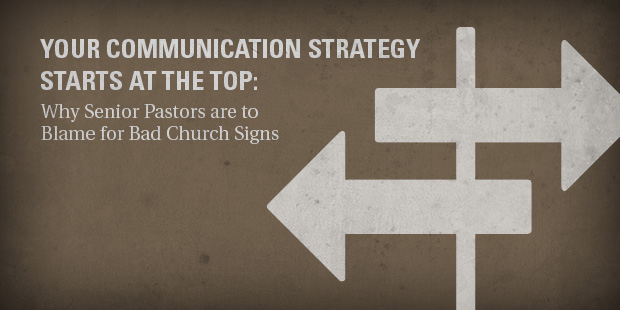
Your Communication Strategy Starts at the Top: Why Senior Pastors Are to Blame for Bad Church Signs
We’ve all seen them—bulletin bloopers and bad church signs. Both provide good fodder for blog consumption. My father is an expert on corny humor, and he has posted on his blog numerous examples of this vital genre of church literature.
- When parking on the north side of the church, please remember to park on an angel.
- Men’s prayer breakfast. No charge, but your damnation will be gratefully accepted.
- The class on prophecy has been cancelled due to unforeseen circumstances.
- A bean supper will be held on Tuesday evening in the church hall. Music will follow.
For the most part, these slips are forgivable offenses. They provoke nothing more than a few chuckles from the observant. But I believe they are indicators of a greater problem within churches: poor oversight of communication.
I blame senior church leaders for bad church signs and bulletin bloopers. Here’s why.
Anything the entire community sees (signs, websites, social media, and printed materials) should have the approval and oversight of a senior leader within the church. If you’re a senior pastor, and you can’t remember the last time you checked out your church website or read the bulletin, then you are neglecting the broadest piece of your church’s communication strategy. All top church leaders should read church tweets, the worship guide, and website updates every week. If you’re not, then you will not have a clear understanding of what information the average churchgoer is digesting each week. Senior pastors should have a thorough understanding of the contents of whatever method a church uses to communicate with a broad audience, church signs included.
The communication strategy of a church is the responsibility of senior leadership. If that’s you, and you’re just as surprised as everyone else by what is on the church sign or in the worship guide on Sunday morning, then you are not leading a communication strategy. Should you write every word in the worship guide? No. But it would help if you read every word before your entire church does. It’s quite surprising to me how church leaders let one person control broad communications to the world. As a senior leader, you should know who is tweeting what. You should know why certain announcements make the bulletin and others do not. It does not mean you’re out there changing the letters on the church sign, but it does mean you should know and approve ahead of time what message is broadcast to many who drive by your church on a daily basis.
The below diagram might get you thinking about a communication strategy. It’s simple. But given the abundance of bad church signs posted in the blogosphere, I hope it is a helpful visual for church leaders.
I’ll call this visual the “big circle/little circle” decision for a communication strategy. A big circle of people requires the knowledge and approval of a senior church leaders. If more will see or hear the communication, then top leaders should approve and edit the message. Websites, Sunday morning announcements, bulletins, and church signs fall into the big circle. A little circle does not require the knowledge or approval of senior church leaders. Examples of little circles are small group handouts and the student ministry brochure.
Senior church leaders who want to oversee and approve small circle communication are micromanagers. Senior leaders who care little about big circle communication are negligent or apathetic. Like everything else in leadership, balance is necessary. In short, if a lot of people will see it, you should approve it. When few people will encounter the message, let others run with it. And if you’re reading this wondering what’s on your church sign, then go check it.
Read more from Sam here.

Tags: Attention, Awareness, Sam Rainer












